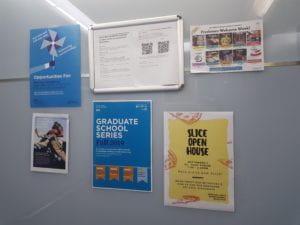
Posters on the walls of the C2 lift
I chose posters that are stuck on the walls of the elevators on our campus as an ‘interaction’. According to the dictionary, ‘interactive’ is defined as ‘a program that is designed to involve the user in the exchange of information’. Although posters aren’t necessarily a type of ‘program’, they provide important information to students and staffs on campus through visual design. The viewers, posters and organizers are all in a mutual interactive relationship since organizers receive attendees in an event, and viewers are informed about such events through posters; posters work as an important connection between organizers and viewers in this interaction.
Since the main purpose of these posters are to inform the students about upcoming events and their locations, these information are therefore prioritized and are visually represented on the posters through typography; the titles take up a greater proportion of the posters than the sub-information to highlight its priority. Some of the posters like the ones designed by the CDC have the color- blue, as their main color to set its brand identity (it also sets a subtle and a professional tone) so that the next time a person sees a poster with its main color as blue, s/he immediately knows it’s from the CDC. In contrast, posters organized by Student Groups such as the ‘SLICE OPEN HOUSE’ have a more welcoming and a warmer tone. There are also illustrations which attract people’s attention while there were a few posters which lacked colors and dimensions, meaning people were drawn less to them.The posters therefore allow people in the lift to initiate conversations about the events, and at the same time pose questions to organizers when some of the information is not clear enough.
There are some constraints to using posters as a sole interaction between the organizers and the viewers however; surplus of posters in the elevator will mean that they will less likely be noticed, and since all the posters are stuck on the walls at an eye-level, posters that are placed elsewhere will not be able to be as effectively interactive as the others. Also, the sizes of the posters are also limited since we all acknowledge that the lift isn’t to solely built to serve its purpose as a poster collection, and therefore are responsible for the space they may be taking up; it would be impractical to have an A1 poster just for the sake of getting people’s attention without thinking about other interactions we have in the space.
Posture switch
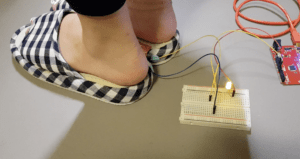
ON
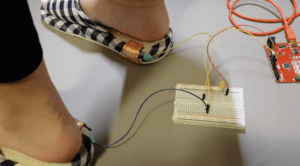
OFF
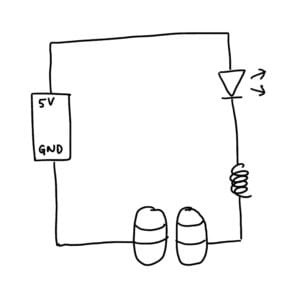
Schematic diagram of the circuit
This temporary switch involves a person wearing a pair of slippers; the LED turns on only when the slippers right against each other and off when they are apart.
This idea came from my personal experience of always having bad posture; I would always stand with my weight down on one leg and let the other hang. The habit of me doing so is starting to break the whole balance of the body where my shoulders and pelvis are slightly tilted to one side.
The circuit wouldn’t necessarily ‘fix’ my posture but I would always be informed by the light whenever I’m not standing up properly.
One of the challenges that I faced while working on this was the random connection of the circuit; sometimes it would work and the light would switch on but other times it just didn’t work. To solve this problem, I had to wrap the tip of the wire with a copper tape, then tape it again on the slippers instead of taping the tip of the wire to the side of the slipper straight away.
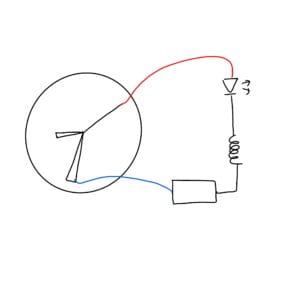
Initial idea
In the beginning, I thought of using a clock as a switch; whenever the second hand passes the minute hand, the light would switch on. But while I was working on this project, I had to question myself the definition of a switch. Do I have to create a switch that can switch on and off by itself or do I need to have control over it.
When I attached the tip of the wire on the second hand with a copper tape, the second hand did not move because the weight of the wire was heavy enough to stop the hand from pivoting.
I couldn’t find a way to solve this problem so I had to come up with a new one, which is the posture switch.
